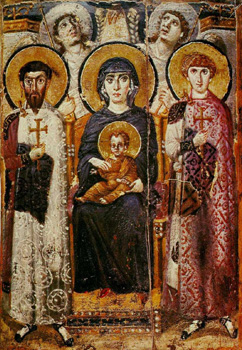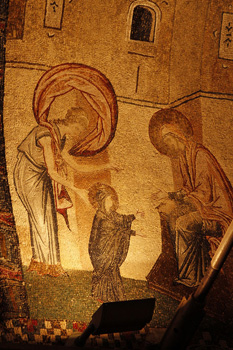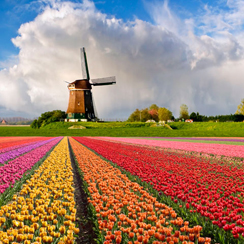Advent follows Thanksgiving.
First we gather with loved ones to give thanks for all of our blessings from the past year (while stuffing ourselves with some of them), and then we begin again — ready to greet whatever adventure God has in store for us in the new church year.
November 20 marked the end of my first year, and the beginning of my second, as a novice in the Community of Saint John Cassian, Order of Saint Benedict. I traveled to Colorado Springs to mark the event with the prior of our community, Fr. Brendan Williams, OSB. We also welcomed a new postulant, Michael Flynn, into our community on that date, which happens to be the Eve of the Presentation of the Blessed Virgin in the Temple. New beginnings, new adventures.
Novitiate Year One has provided many opportunities for thanksgiving. Primary among these is the deepening of my journey with Jesus, which has been far more rich than I anticipated. When I was considering monastic life more than a year ago and praying about it, I received a mental image of my spiritual walk at the time as a footpath along connecting ridges at the very top of beautiful but mostly barren mountains. I could keep walking from one peak to the next, and I could see a long way ahead. Monastic life appeared to me as a path that branched off of that one, and descended into a valley filled with thick forest. I couldn't see very far in advance that way, but I could tell that I would find things there that I had never seen before. As the vision passed, I knew that was the path I was called to take. I have not regretted it.
 |
|
Virgin and Child with angels and Sts. George and Theodore. Icon from around 600, from St. Catherine's Monastery (Egypt).
|
Monastics have the option to take a religious name. I was perfectly happy with my given name, and I already had a nickname as well, so yet another name seemed somewhat superfluous — but the idea behind taking a new name is that we leave our old life behind and put on a new life, in the same way that we take off our secular clothing and don the monastic habit during the ceremony for the vows of a Novice. That ceremony also includes a lengthy, full prostration before the altar, symbolizing death to the old way of life.
I considered many names, and eventually narrowed it down to three: Theophan (for Theophan the Recluse, whose writings on unceasing prayer inspired me greatly), John (the Evangelist, the Baptist, Cassian, of the Ladder, of the Cross, and many more), and Eckhart (for Meister Eckhart, the 14th century mystic).
My prior instructed me to keep a vigil, during which it became clear to me that even though I still have much to learn from Theophan and all the Johns, for me they represented qualities I could already embrace. Eckhart, on the other hand, is more challenging. He is that unexplored path down into the forest. The name that God would give me is not for what I already am, but for what I am to become.
I had no trouble understanding Eckhart's insistence on transcending all concepts — even our concepts of God. I had learned that principle from the Tao Te Ching, which has startling parallels in Eckhart's thought, although it is unlikely he could have ever read it or heard of it. But Eckhart goes further, daring to give names to the Unnameable while still knowing that the names are insufficient.
Eckhart often writes about the Father giving birth to the Son within us, in the Ground of Being, which our spirit shares with God. This is the third incarnation. The first is the Word spoken at creation, making all things an incarnation of the deity. The second is the Word made flesh, Jesus, the man who is God among us. The third incarnation is when the Word is born in us, and we are taken into union with God. That can only happen if we let it — if we humbly lay down our own life in preference for God's.
Monastic vocation provides a set of practices and teachings, gathered from the wisdom of many who have gone before us, to guide us on that essential Christian path. It involves praying frequently, with the aim of making our prayer unceasing — because prayer is union with God.
 |
|
The Virgin's first seven steps, mosaic from Chora Church (Istanbul), c. 12th century.
|
Because the opposite of union with God is asserting our ownership, monastic life involves giving up things: sexual intimacy, exclusive relationships, and the extravagant lifestyle we have come to take for granted.
Much more difficult than these to surrender, though, are my deep-seated addictions to praise and reputation, and the need to control my own destiny. Anything I have trouble surrendering is a proxy for my need to control things, which in turn is based on my fear that things will go horribly wrong if I am not in control. This, of course, is making myself equal to or greater than God, which is pride and idolatry.
I understand why Saint Benedict (and indeed also the New Testament) advocates unconditional obedience, not only to my prior, but also to everyone else. That kind of obedience is only possible when we relinquish control with all humility — when we truly die to ourselves, take up our cross, and follow our Lord. We must be crucified with Christ.
Union with God is the goal of the monastic life.
It is also the goal of Christian life.
It is the goal of life.
It is life.
Anticipating that union, we can sing with the Holy Virgin:
My soul proclaims the greatness of the Lord.
My spirit rejoices in God my Savior;
for he has looked with favor on His lowly servant.
If the incarnation of Christ is the humility of God, the Virgin Mary represents the most humble of human responses: surrender, and give thanks for the birth of the Word within us.
Advent follows Thanksgiving.
Peace, Br. Eckhart
Image credits: (1) Wikipedia.org and (2) Wikipedia.org.



